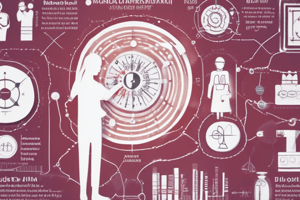Podcast
Questions and Answers
What is the primary focus of biostatistics?
What is the primary focus of biostatistics?
- The collection and analysis of economic data
- The collection and interpretation of biological and biomedical data (correct)
- The classification of geographic information
- The statistical analysis of social behavior
Which statement best describes the relationship between populations and samples in statistics?
Which statement best describes the relationship between populations and samples in statistics?
- Population characteristics are inferred from sample characteristics. (correct)
- Population characteristics can be measured directly, while sample characteristics cannot.
- Sample characteristics are always better known than population characteristics.
- Samples represent the entire population without bias.
What occurs when there is bias in data selection or measurement?
What occurs when there is bias in data selection or measurement?
- Data will reflect real differences with certainty.
- Meaningful results cannot be obtained from the data. (correct)
- Sampling will become more representative.
- The analysis will always yield accurate results.
What is one important role of biostatistics in clinical research?
What is one important role of biostatistics in clinical research?
Which step in clinical research involves verifying the integrity of the data collected?
Which step in clinical research involves verifying the integrity of the data collected?
What should a research study ensure for its validity?
What should a research study ensure for its validity?
What is represented by the rows in a tabular data form?
What is represented by the rows in a tabular data form?
What type of variable is 'sex' classified as?
What type of variable is 'sex' classified as?
Which of the following represents a primary key in a dataset?
Which of the following represents a primary key in a dataset?
Which conversion between variable types is correct?
Which conversion between variable types is correct?
What does NA represent in R programming?
What does NA represent in R programming?
In vector indexing, what does the indexing operator [ ] do?
In vector indexing, what does the indexing operator [ ] do?
Which kind of variable allows for a limited number of distinct values?
Which kind of variable allows for a limited number of distinct values?
Flashcards are hidden until you start studying
Study Notes
What is Biostatistics?
- Biostatistics deals with the collection, classification, analysis, and interpretation of biological and biomedical data.
- It is a specialized area of statistics focusing on health-related data.
Populations and Samples
- Population characteristics are not known but can be inferred from the sample.
- Sample characteristics are known and can be measured.
- To make accurate inferences, appropriate sample selection and accurate measurement are crucial to avoid bias.
Biostatistics in Medicine
- It helps generate medical knowledge by understanding natural and experimental observations in science and medicine.
- It assists in designing, managing, and analyzing clinical trials.
- Biostatistics helps to determine how diseases develop, progress, and spread.
The Steps of Clinical Research
- The steps include study design, data collection, data processing, data analysis, and output results.
- Statistical software, such as R, can be used for data analysis.
Reproducible Research
- A research study should be reproducible to ensure the reliability of the results.
- Code should be used throughout the steps of a research study, from data processing to results presentation.
Data in Tabular Form
- Data is often presented in a tabular (rectangular) format.
- Each row represents an observation, while each column represents a variable.
- A primary key uniquely identifies each observation.
Types of Variables
- Variables can be categorized as categorical (non-numerical) or numerical.
- Categorical variables can be nominal (without inherent ordering), ordinal (with inherent ordering), or dichotomous (binary).
- Numerical variables can be continuous (measurement on a continuous scale) or discrete (limited number of discrete values).
Different Types of Variables Require Different Statistical Approaches
- Statistical methods used for analysis depend on the type of variable.
Data Conversion
- Variables can be converted between different types:
- Numerical variables can be converted into categorical variables (e.g., age to age group).
- Categorical variables can be converted into numerical variables (e.g., class to length).
- “NA” represents missing values in R.
Vector Indexing
- Indexing in R allows selecting elements from a vector or other objects using the indexing operator
[ ]. - There are four ways to use the indexing operator
[ ].- Positive integer vector: Specifies the positions of the elements to keep.
- Negative integer vector: Specifies positions of the elements to remove.
- Character vector: Identifies elements by their names.
- Logical vector: Selects elements based on a condition.
Studying That Suits You
Use AI to generate personalized quizzes and flashcards to suit your learning preferences.




